Is it possible to keep a gas cylinder in an apartment: norms and rules for using bottled gas
Explosions of gas cylinders in high-rise buildings and private houses have one reason - non-compliance with the rules of storage and use. All requirements are spelled out and approved by law. However, doubts remain: is it possible to keep a gas cylinder in an apartment, how to install it correctly and who should control all this - frequent questions from users.
Let's figure out together how to properly store and use gas cylinders, and also find out the main mistakes that users make when installing equipment.
The content of the article:
What does the law say?
The latest amendment to Decree No. 390 “On the fire safety regime” (dated April 25, 2012) dates back to March 7, 2019.
The new version states that:
- it is prohibited to store containers with flammable gas in houses and apartments, in stairwells and basements, on balconies and attics;
- Each cylinder must be located in a special annex - a cabinet, locked and equipped with a warning sign “Flammable. Gas".
The exception is five-liter containers that are already connected to the stove and are actively used. In this case, the stove must be of factory origin; the use of homemade/modernized copies is not allowed.
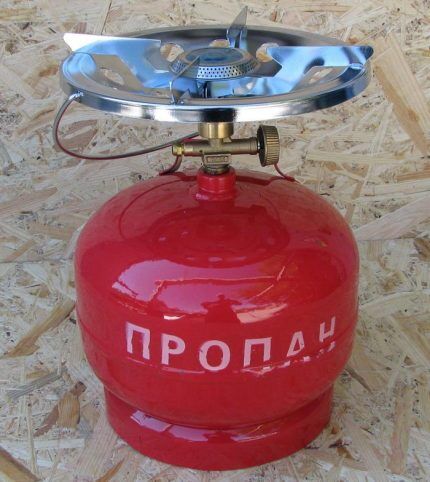
Where to buy and refill?
The container itself can be purchased in construction stores and on specialized online portals. Municipal gas services will help replace or refill it. If the consumer plans to independently deliver gas to his home, the seller is obliged to provide comprehensive instructions for transportation, installation and testing of equipment.
We also recommend reading our other article, where we talked in detail about the technical requirements for gas cylinders and the technology for refilling them. More details - go to link.
People who successfully complete the training are given instructions on all stages of handling the equipment and a certificate for the smooth replacement of empty containers in the future.
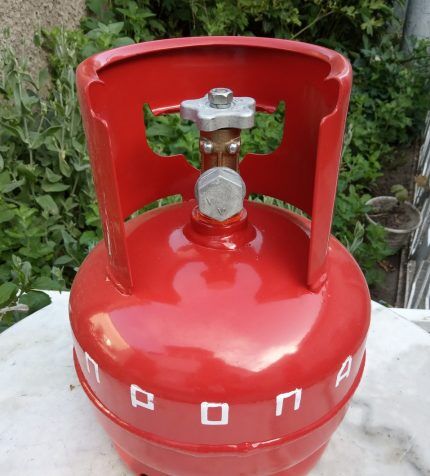
The main difference between the models available today is the design of the locking device. On earlier products you can see the valve.
Modern products are equipped valve. According to professional gas workers, the valve is more convenient and safer for use at home. It is better to give preference to long-term storage of the valve device.
Subtleties of the location of the cylinder in the apartment
The answer to the question whether it is possible to store a gas cylinder in an apartment is clearly negative. And placement for connection is possible.
It is important to follow the rules:
- The distance between the stove and the fuel container cannot be less than 100 cm.The exception is shielded versions that allow installation at a distance of 50 cm.
- The gas tank should be a meter or more away from any heat source.
- It is imperative to maintain free access to all locking devices - valves and taps.
The above standards also apply to the placement of old, already used equipment. It cannot be stored in an apartment. But if you cannot avoid this for some period of time, then you should remember the rules.
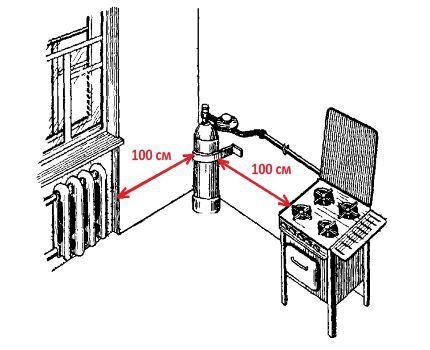
It is better if the installation and replacement of the tank is carried out by specialists from a certified gas service.
This will avoid basic mistakes:
- starting installation without checking the tightness of the tank valve outdoors;
- carrying out work in a closed, unventilated room;
- deviations from the vertical position;
- using the wrong tool.
Leak testing is carried out outdoors. A soap solution is applied to the place where the stem exits the valve. Then the transport fuse (plug) is removed and the fitting hole is lathered. Bubbles that appear are a good reason to refuse to use the equipment.
Some expert advice
The installation algorithm is the same for all stoves and hobs designed to work with gas.
After preparing the tool and components, you must:
- Connect the inlet pipe of the plate and the fitting. To seal the connection you can use FUM- tape or special gaskets.
- Connect the hose to the fitting.Note the presence of an O-ring on the inside surface of the nut. And to seal the threaded connection, you can use sealing tape.
- Attach the gearbox nut to the valve. Since the plates are equipped with jets designed for constant pressure, it is recommended to use a reducer. It normalizes blood pressure, which decreases as it is used.
- Attach a rubber hose to the gearbox and secure with a clamp.
Before turning on, it is necessary to check the tightness of all connections. If at least one of them demonstrates inadequate tightness, it is unacceptable to use gas. The installation needs to be re-installed.
For more detailed instructions on connecting a gas cylinder to the stove, read this material.
Rules for using the equipment
Unfortunately, the rules for using gas cylinders in apartment buildings are based on sad experience. All of them are intended to warn against the repetition of tragedies that have already happened.
Forbidden:
- allow the tank to heat up;
- cover the container with fabric or any materials that do not allow air to pass through, creating a greenhouse effect;
- repair the valve or threaded connections yourself;
- eliminate the causes of difficulties when opening the valve without the help of specialists. In this case, it is recommended to call a gas brigade;
- allow children, as well as adults with mental and memory impairments, to use the stove without the supervision of capable adults;
- leave equipment switched on and unattended.
Failure to comply with the rules for using equipment can result in a serious tragedy, for example, gas cylinder explosion. Therefore, before each ignition, the user must ensure that there is no gas odor. Once smelled, it is easy to distinguish it from other odors. It is advisable to teach how to distinguish the smell of gas and children living in the apartment.

Then follow the developed algorithm:
- Check the stove taps - they must be locked in a closed position.
- Open the cylinder valve.
- Bring a household lighter or a lit match to the burner.
- Turn the tap of the desired burner to the open position.
If a strong flash occurs when you first turn it on, you must tighten the gas container tightly and call the emergency team. Intense ignition is a sign that the tank is overfilled. In this case, operation is prohibited.
Since the room where gas-powered appliances are used must be regularly ventilated, it is necessary to ensure access to fresh air.
And one more rule that will help avoid annoying consequences. At the end of cooking, the first step is to turn off the valve of the fuel container, and then the stove taps. Following this rule prevents leaving equipment open.
Causes for concern
Often, when cooking, situations arise related to low-quality fuel or equipment malfunction.
To respond to them correctly, it is worth knowing the signs of incorrect operation:
- The red color of the flame coming from the burner. The main reason is a lack of oxygen (fuel does not burn completely), which can be mitigated by simple ventilation. Also, the source of trouble in this case may be low quality fuel.
- Appearance of soot. A sure sign that the outlet pressure significantly exceeds the permissible norm. The problem is solved by replacing the jets.
- Whistle, noise, hum emanating from the stove when turned on. As a rule, extraneous sounds appear due to severely clogged injectors. If everything is fine with them, you need to reduce the pressure on the gearbox.
If you can cope with simple troubles on your own, then to solve more complex situations it will not be superfluous to turn to professionals.
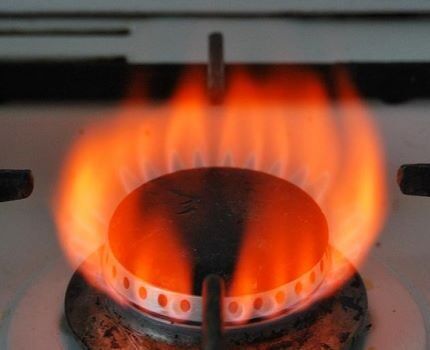
For example, if a neighbor installed a fuel tank in an apartment and ignored safety requirements, this situation should not be hushed up. The use of such equipment is monitored by specialized municipal services. However, practice shows that access to such services is not always characterized by their quick response.
Lawyers suggest a more effective way. If a citizen living nearby, in an apartment located in the entrance/building, does not comply with safety precautions when handling explosives, and does not heed admonitions, he should dial “112”. All calls to this number are recorded. Therefore, the reaction to them turns out to be more dynamic.
Depending on the nature of the violations, specialists will send representatives of the police, fire department or gas service to the address. The legality of the installation, the technical condition of the equipment and compliance with safe operating conditions will be checked on site.
Rules for storing empty containers
The attitude towards an empty container should be exactly the same as towards a just filled one. Empty containers should be stored tightly closed in a separate room. Therefore, an apartment is not suitable for storing gas cylinders, even used ones.
An old tank cannot be:
- open, saw, cut;
- heat;
- use for the manufacture of explosive devices, including for peaceful household or construction purposes;
- get rid of the remaining gas yourself;
- scrap metal without proper treatment.
Used equipment should be taken to a collection point of a specialized service for inspection or replacement.
Checking gas cylinders
Each container is equipped with a stamp or a metal “passport”, which indicates expiration, storage and pressure testing dates. Crimping is a test for suitability. During such a check, specialists unscrew the valve and inspect the internal surface.
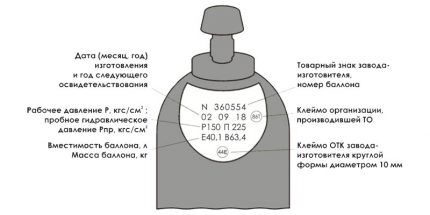
If the walls are in order, there are no visible damages on them, the tank is filled with water and subjected to pressure testing: a pressure is injected that is one and a half times higher than the operating values.
The container that remains intact after such an event is “awarded” with an updated stamp and is allowed for further use.
External signs of faulty equipment
Any user can independently determine the unsuitability of a container by external signs:
- the presence of rust - products are not subject to further use, more than a third of the surface of which is occupied by corrosion;
- the presence of traces of fire - a damaged layer of paint;
- swelling - barrel-shaped specimens with a distorted shape;
- presence of dents.
All these signs are reasons for prompt disposal. Another good reason is the expiration of the storage period, information about which is displayed on the stamp.
Procedure in case of gas leak
If a clear smell of gas appears, it is recommended to tighten the cylinder valve, turn off the stove and open the windows. For intensive ventilation, you can open windows not only in the kitchen, but also in other rooms of the apartment. A high concentration of a substance in the air is a reason to seek the help of specialists, call representatives of the municipal gas service to your home.
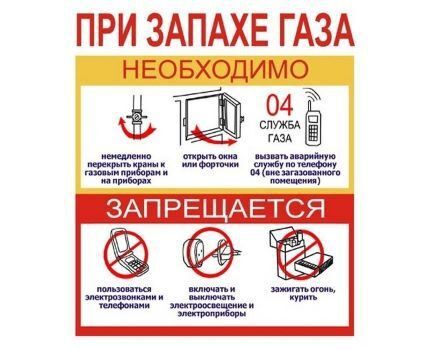
It is prohibited to use lighters and matches, light a cigarette, or turn on the stove. Until the leak is eliminated, you should not use devices that require connection to the electrical network. Before the team arrives, all residents of the apartment (including animals) must leave the premises.
To avoid poisoning and more tragic consequences of a leak, you can use special sensors or gas monitoring kits. Equipped with light and sound alarms, these devices will inform you of a problem before a noticeable odor appears.
Conclusions and useful video on the topic
To summarize, it can be argued that storing gas cylinders in an ordinary apartment is prohibited. It is allowed to use 5-liter tanks connected to the factory-made stove.It is important to observe the distances specified in the requirements and always monitor the operation of the equipment.
The example of a hob shows how to connect a gas cylinder. Please note that upon completion of work, the connections are checked for tightness:
You can provide interesting information on the topic, ask a question to experts, share your experience, or participate in the discussion of this material - the communication block is located under the article.




Where is it written that five-liter cylinders are allowed in city apartments? I can’t find such a clause in the resolution.
In apartment buildings it is not allowed to install gas cylinders directly in the apartment. But setting up a special utility room next to the house and running hoses from it into the apartment is a good idea. I am now talking about large 50 liter cylinders. But for 5 liter cylinders you don’t need any permits, but its volume will not be enough for a long time.
But who in our country follows the rules, it’s good if 50%... About ten years ago you could keep gas cylinders in your apartment: you register them with the gas workers, agree on refilling the cylinder with a replacement, check the equipment and connections for wear periodically and that’s it. But now, due to accidents, it is prohibited to use large gas cylinders in apartments. For private houses, the project must be coordinated with gas workers.
And another very important point: do not allow sudden changes in temperature, for example, when you bring a filled cylinder in winter, you do not need to immediately bring it into a warm room.
We have an apartment building (17 floors) with electric stoves.A neighbor in the common vestibule leaves a gas cylinder in a wooden box, which he uses when installing (part-time work on) suspended ceilings. The vestibule smells of gas. He ignores our requests to remove the gas cylinder. Is this dangerous and what should I do?
My neighbor brought a 5 liter gas cylinder to the dorm. He stores a gas cylinder in a common corridor, is it possible to do this?
It is important to follow the basic rules for storing gas cylinders: - store the gas cylinder away from open flames. Also, do not place it near exposed electrical wires or various heaters. Keep the container in the shade, as the rays of the sun will heat the container, the pressure in it will rise and this can cause a tragedy; — store the cylinder in a place where it cannot become contaminated with lubricants or oils.